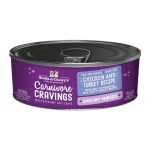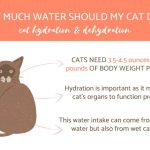Mastering The Art Of Transitioning Your Cat From Dry To Wet Food: A Step-by-Step Guide For A Healthier Feline Diet!
How to Transition Your Cat from Dry to Wet Food
Introduction
Welcome, Cat Enthusiast! If you’re considering transitioning your feline friend from dry to wet food, you’ve come to the right place. As a cat owner, it’s essential to provide your pet with a balanced and nutritious diet. This article will guide you through the process of safely transitioning your cat from dry kibble to wet food. Making this change can have a positive impact on your cat’s overall health and well-being. So, let’s explore the steps you need to take to make this dietary transition a smooth and successful one.
1 Picture Gallery: Mastering The Art Of Transitioning Your Cat From Dry To Wet Food: A Step-by-Step Guide For A Healthier Feline Diet!

What is the Transition from Dry to Wet Food?
🐾 Transitioning your cat from dry to wet food refers to gradually introducing your feline companion to a new diet consisting of canned or pouch wet food. This change is necessary for various reasons, such as addressing specific health issues, improving hydration, or simply providing a more palatable meal for your cat.

Image Source: ctfassets.net
🐾 Wet food typically contains a higher moisture content, which contributes to your cat’s hydration needs. Additionally, it can be easier to digest and offers a more diverse range of flavors and textures, making mealtime more enjoyable for your furry friend.
🐾 However, it’s important to note that every cat is unique, and consulting with your veterinarian before making any dietary changes is crucial. They can provide personalized advice based on your cat’s specific needs, age, and health condition.
🐾 Now, let’s delve into the details of transitioning your cat from dry to wet food and ensure a seamless switch that benefits your beloved feline.
Who Should Consider Transitioning?
🐾 Cats of all ages and breeds can benefit from transitioning from dry to wet food. However, certain cats may particularly benefit from this dietary change:
🐾 Cats with urinary tract issues: Wet food can help increase your cat’s water intake and promote urinary tract health.
🐾 Senior cats: As cats age, their sense of smell and taste may diminish, making wet food more appealing due to its stronger aroma and flavor.
🐾 Cats with dental problems: Wet food is easier to chew and swallow, making it a suitable option for cats with dental issues.
🐾 Picky eaters: Some cats may simply prefer the taste and texture of wet food, making the transition a great option for finicky eaters.
🐾 Always consult with your veterinarian to determine if transitioning to wet food is the right choice for your cat’s specific needs. They can provide valuable guidance based on your cat’s individual health and dietary requirements.
When is the Best Time to Transition?
🐾 Timing is crucial when it comes to transitioning your cat’s diet. It’s recommended to introduce dietary changes gradually to avoid any digestive upset or refusal to eat.
🐾 The transition process should ideally begin when your cat is in good health and not experiencing any major stressors or changes in their environment. This ensures that the switch to wet food is as smooth as possible.
🐾 Additionally, it’s important to consider any other health conditions your cat may have. If your cat has specific dietary requirements or is currently undergoing treatment, consult with your veterinarian before initiating any dietary changes.
🐾 Ultimately, the best time to transition your cat to wet food is when you have carefully planned and prepared for the change, taking into account your cat’s unique needs and circumstances.
Where to Begin the Transition?
🐾 The transition process involves gradually introducing wet food while reducing the amount of dry food your cat consumes. Here’s a step-by-step guide to help you get started:
🐾 Step 1: Consult your veterinarian: Before starting the transition, seek guidance from your veterinarian. They can provide specific instructions based on your cat’s individual needs.
🐾 Step 2: Choose the right wet food: Select high-quality wet food that meets your cat’s nutritional requirements. Look for options that are free from artificial additives and fillers.
🐾 Step 3: Determine the feeding schedule: Decide how many meals your cat will have each day and establish a feeding schedule. This will depend on your cat’s age, activity level, and preferences.
🐾 Step 4: Begin the transition: Start by mixing a small amount of wet food into your cat’s dry food. Gradually increase the proportion of wet food while decreasing the dry food over the course of several days or weeks.
🐾 Step 5: Monitor your cat’s response: Observe your cat’s behavior and appetite during the transition. If any issues arise, consult with your veterinarian to ensure a smooth adjustment.
🐾 Step 6: Complete the transition: Once your cat is comfortable with a higher proportion of wet food, you can fully replace the dry food with wet food. Remember to provide fresh water at all times.
🐾 Step 7: Maintain a balanced diet: After the transition, ensure your cat receives a balanced diet by selecting a variety of wet food flavors and alternating them to cater to their preferences.
Why Transition from Dry to Wet Food?
🐾 Transitioning your cat from dry to wet food offers several benefits:
🐾 Increased hydration: Wet food provides a higher moisture content, helping to prevent dehydration and promote kidney health.
🐾 Improved digestion: Wet food is easier for cats to digest, reducing the risk of digestive issues such as constipation or hairballs.
🐾 Enhanced appetite: The aromas and flavors of wet food can entice picky eaters, encouraging them to consume an adequate amount of nutrients.
🐾 Weight management: Wet food can help control your cat’s weight, as it often contains fewer carbohydrates and calories compared to dry food.
🐾 Dental health: The softer texture of wet food is gentler on your cat’s teeth and gums, promoting better oral health.
How to Transition Cat from Dry to Wet Food – Pros and Cons
🐾 Advantages:
1. Improved hydration: Wet food can help prevent urinary tract issues and promote kidney health.
2. Enhanced palatability: Wet food’s stronger aroma and flavors can entice picky eaters to consume a nutritious meal.
3. Easier digestion: The moist texture of wet food is gentler on the digestive system, reducing the risk of constipation and hairballs.
🐾 Disadvantages:
1. Higher cost: Wet food is generally more expensive than dry food due to its higher quality ingredients and packaging.
2. Shorter shelf life: Once opened, wet food needs to be refrigerated and consumed within a few days.
3. Dental concerns: Wet food may not provide the same dental benefits as dry food, which can help remove plaque and tartar.
Frequently Asked Questions
Q1: Can I mix dry and wet food together?
A1: Yes, it’s possible to mix dry and wet food for your cat. However, it’s essential to maintain the correct proportions and monitor your cat’s response.
Q2: How long does the transition process take?
A2: The transition process can vary depending on your cat’s individual preferences and adaptability. It may take several days to a few weeks for your cat to fully adjust to the new diet.
Q3: Should I consult my veterinarian before transitioning?
A3: Yes, it’s crucial to seek guidance from your veterinarian before making any dietary changes. They can provide personalized advice based on your cat’s specific needs and health condition.
Q4: Can wet food be fed as the sole diet for a cat?
A4: Yes, wet food can be fed as the sole diet for your cat. However, it’s important to ensure that the chosen wet food meets all of your cat’s nutritional requirements.
Q5: How do I know if my cat is allergic to certain ingredients in wet food?
A5: If you suspect your cat has food allergies, consult with your veterinarian. They can help identify potential allergens and recommend appropriate dietary adjustments.
Conclusion
In conclusion, transitioning your cat from dry to wet food is a process that requires careful planning and monitoring. By following the steps outlined in this article, you can ensure a smooth and successful transition that benefits your cat’s overall health and well-being.
Remember, consulting with your veterinarian is crucial to address any specific concerns or health conditions your cat may have. With patience and perseverance, you can provide your feline companion with a balanced and satisfying diet that keeps them happy and healthy for years to come.
Final Remarks
Disclaimer: The information in this article is for educational purposes only and should not replace professional veterinary advice. Always consult with your veterinarian before making any changes to your cat’s diet or addressing any health concerns.
This post topic: Cats



